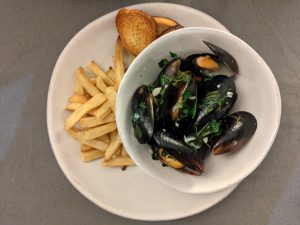What you will need:
Mussels (2-4 dozen, or 2-3 lbs; frozen package or live)
4 tablespoons garlic (or as much as you like!)
1/3 cup+ Italian parsley
2 tablespoons butter
¼ cup olive oil
1 cup white wine (your favorite)
French fries (frozen package or make your own)
Baguette, sliced into rounds
Difficulty of recipe
Simple
Total time to make
30-35 minutes – Most of the time is for cooking the French fries. Cooking the mussels should only take ~10 minutes.
Recipe instructions
Prepare the rest of the recipe while the fries are cooking.
- Prepare French fries. Pre-made frozen fries typically take ~20-25 minutes to bake.
- Mince garlic and chop parsley. Set aside.
- Heat butter and olive oil in a deep pot on medium-high.
- Add garlic and cook until softened.
- Pour in white wine and ½ of chopped parsley.
- Place mussels in pot.
- Bring sauce to boil and then simmer until mussels are open (for live mussels). For frozen mussels, cook until they are thawed and hot.
- While mussels and fries are cooking, toast baguette rounds by broiling in the oven, 2-3 minutes each side (watch to keep from burning!).
- Just before serving mussels, stir in remaining parsley.
- Spoon mussels and broth into bowl and serve with French fries (+ ketchup or your favorite dipping sauce) and toasted baguette rounds on the side for dipping into broth.
- Eat and wash down with the rest of the white wine!

Species Profile
Mussels, of the genus Mytilus, live in temperate to polar waters. In their natural habitat Mytilus spp. grow in the low and mid intertidal regions of the rocky intertidal and can form extensive beds, attached to rocks and each other by their byssal threads. These beds are important to the ecology of the rocky intertidal zone as a key component of the food web, habitat for other species and as filter feeders. In general, they are also very successful inhabitants of the intertidal zone, exhibiting extremely high tolerance to desiccation and high temperature when exposed at low tide, and resistance to strong wave action. Mussels have also served as an important barometer of the effects of climate change, as they exist at the edges of their physiological tolerances in the extreme environment of the rocky intertidal.
Mussel farming
Mussels are widely farmed around the world and sold live or frozen. The common native species eaten on the eastern seaboard of North America is the blue mussel, Mytilus edulis. Other species of Mytlius have been transported from their native ranges for aquaculture. For example, in the Pacific Northwest farmers grow the Mediterranean mussel Mytilus galloprovincialis. Farmers collect juvenile mussels, or spat, on ropes. The ropes are suspended from rafts or buoys. Mussels are harvested when they reach at least 40 mm or greater (~1 year+). There are other methods to farm mussels (sticks, or bouchots, and bottom culture), but rope culture is the most common. Spat are typically collected from the wild, but hatchery production of mussel seed is also an option for farmers.
Popularity of the dish
Moule frites is a very popular dish in Belgium and France. In fact, it is the national dish of Belgium, and one of the most popular dishes in France. It is as Belgian or French as cheeseburger and fries are American. You’ll find it commonly served in restaurants and as pub fare accompanying a cold beer or glass of white wine. As a comfort food, it is quite easy to prepare in the home, especially if you have frozen mussels ready to throw in the pot. It is one of our go-to family dishes when we are pressed for time and want to re-create an inexpensive culinary experience from the Gallic side of our family.
Health benefits
Mussels are high in protein and low in saturated fat. They are rich in omega-3 fatty acids, and good for your heart and brain! They are also high in zinc and vitamins A and B12.
Where to buy
Your local seafood market. You may find live mussels, often farmed blue mussels (M. edulis) grown in New England or Canada. Or you can easily find imported, frozen mussels in most supermarkets.
Safety
Cooked mussels are very safe. If necessary, scrub live mussels a bit to remove the “beard” (byssal threads). Cook until they open. Unlike oysters, live mussels do gape. You can test if they are still alive by tapping them. If the shells close, they are alive and safe to cook. If they do not close, discard them. For frozen mussels, simply heat them. They are already processed and cooked.
Sustainability
Farmed mussels are widely recognized as a sustainable source of seafood, relying on natural phytoplankton for food, and causing minimal environmental impacts to surrounding waters. Farmed mussels are classified as a “Best Choice” for a sustainable source of seafood. There is some concern with wild harvesting by dredge which can damage habitat. This is a small fishery, however, keeping impacts minimal.
Seafood cost
Low to Moderate. The total cost (not including the wine) of the meal for a family of four was ~$28. This included 2 packages of frozen mussels (~$13 for 2 one lb boxes) and the full cost (not by portion) of all grocery items including olive oil and butter.
 0
0
